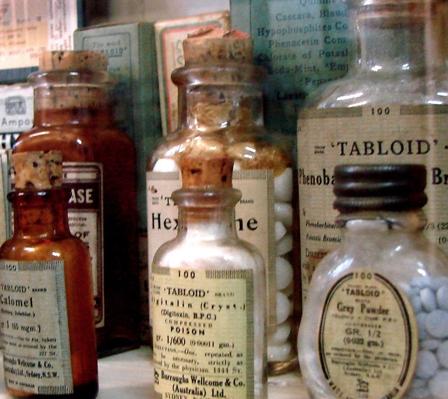Reprinted by permission of McGill University Office for Science and Society.
###
"Since calomel’s become their boast,/ How many patients have they lost?/ How many thousands they make ill,/ Of poison with their calomel?” So ran a little verse written in 1825 by an unknown poet who was obviously disenchanted with medical practice of the day. “Calomel” was the curious name given to mercurous chloride, Hg2Cl2, the most common medicine of the era. Why curious? Because the name derives from the Greek “calos” meaning “good,” and “melas” for “black.” Well, calomel was neither black nor good. The “black” is thought to refer to the precipitation of finely dispersed black metallic mercury when calomel reacts with ammonia and the “good” was what calomel was supposed to do for a sick person.
The writer of that little poem, who could have benefited from a rhyming dictionary, had the right message. Calomel didn’t cure people, it made them ill. How is it then that calomel, along with other metal salts, was commonly used by physicians for some five hundred years as standard therapy for almost every disease?
First, many diseases are self-limiting and resolve by themselves. But when calomel was given, it got the credit. Second, the belief that it would help was often enough to make a patient feel better. The “placebo” effect is very powerful indeed. Third, patients were often so sickened by calomel that they professed to feeling better just to avoid further therapy. Fourth, people who succumbed to calomel poisoning were not around to register complaints about the treatment. And finally, in rare cases, mercury compounds may actually have cured a disease. Mercury can poison all kinds of organisms, including bacteria. Syphilis was a bacterial scourge throughout history, and if a physician happened to get the dose just right, mercury compounds sometimes killed the bacteria without killing the patient.
The use of mercury to treat disease can be traced back to Paracelsus, the sixteenth century physician, alchemist and philosopher. At the time, medicine was based on the ancient Greek idea that health was a reflection of the balance between the four humours, namely black bile, yellow bile, phlegm and blood. Paracelsus decreed that this was bunk, and expressed his disgust of the uncritical reliance on ancient authorities by publicly burning their works. He insisted that the physician should explore the world and learn from nature. For every disease nature provided a cure, Paracelsus suggested, and the physician’s role was to find it. And in mercury compounds, he thought he had found a cure for many conditions. To his credit, though, Paracelsus recognized that mercury could also be a poison, and insisted that dosage was critical. Indeed, his dictum that “only the dose makes the poison,” is still the cornerstone of toxicology. But he never realized how little mercury it actually took to cause a great deal of harm.
Where did Paracelsus and his followers get calomel? They had to prepare it from cinnabar, naturally occurring mercuric sulphide. Heating this red ore in air drives off the sulphur as sulphur dioxide and leaves behind shiny mercury metal. Treatment with sulphuric acid, prepared since ancient times by heating naturally occurring iron or copper sulphate, forms mercuric sulphate, which in turn, when heated with ordinary salt produces mercuric chloride, a white powder with formula HgCl2.
To Paracelsus, the production of a white crystalline substance after all that messy and smelly manipulation must have seemed astonishing. Could this be one of the elusive substances that nature provided for mankind’s benefit? There was only one way to find out, try it. Without doubt, mercuric chloride had an immediate effect. The patient gave up the contents of his bowels quickly, a sign that disease was being driven out of the body! And so began the age of “heroic medicine,” characterized by doctors attempting to bludgeon the disease out of the patient.
Mercurials and antimony compounds evacuated the digestive tract in both directions, and were often coupled with blood letting to rid the body of disease. Often, they rid the body of life. Particularly when the highly toxic mercuric chloride was used. Since dead patients were not good for business, or for reputation, a safer purgative was desirable. Heating mercuric chloride with some more mercury, produced mercurous chloride, or “calomel.” It was still a cathartic, but being far less soluble than mercuric chloride, it was less toxic.
That’s not to say it was safe. When given over a period of time, as was common practice, calomel would cause excessive salivation, gum inflammation and various neurological symptoms. Patients developed tremors, balance problems and personality changes. But doctors lacking truly effective medications, continued to torment the ill with calomel. George Washington was administered it on his death bed, probably hastening his demise.
The original McGill University OSS post can be found here.




